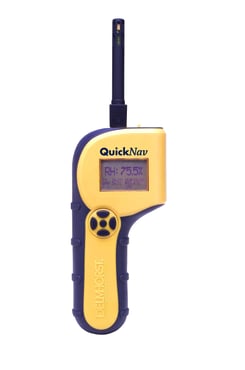 Moisture intrusion is a major concern for restoration work. Incomplete assessments of moisture in a structure can lead to faulty work, creating risks of mold growth, further structural decay, and other hazards.
Moisture intrusion is a major concern for restoration work. Incomplete assessments of moisture in a structure can lead to faulty work, creating risks of mold growth, further structural decay, and other hazards.
To complete restoration jobs quickly, efficiently, and thoroughly, it’s important to have the right tool for measuring the moisture content of various building materials. But, how can you be sure you have the best tool for the job?
Knowing what kind of moisture meter works best for restoration is a good place to start. With this in mind, here’s a quick assessment of the different kinds of moisture meters on the market, and how you can pick the best one for restoration work:
Pinless Meters
For the fast detection of moisture in building materials, pinless moisture meters are an excellent tool. Their electromagnetic scanning method covers a relatively large area with each measurement. Many in the restoration industry rely on these meters for fast evaluations of how heavily moisture-compromised building materials are.
Additionally, these meters are non-destructive, leaving building materials unharmed. This makes pinless meters great for checking materials that you don’t want to damage if you don’t have to.
Pin-Type Meters
While pinless meters use electromagnetic waves to scan a large area all at once, pin-type moisture meters use the principle of electrical resistance to measure moisture between two pins. Wood is a natural insulator; water is a conductor. So, the less resistance there is to the electrical current, the more moisture is present.
Pin-type meters can only detect the presence of moisture between the pins, making them less suited for checking large, open areas. However, there are several advantages to using pin meters:
- They can be used on contoured or uneven surfaces without a problem. Pinless meters require a flat contact surface to get accurate readings.
- They can determine the exact depth and displacement of a moisture pocket. Because pin-type meters have a narrow testing area, determining exact depth and area for a moisture pocket is easy.
- Insulated pins aren’t affected by surface moisture. By insulating pins to only read at the very tips, surface moisture is eliminated as a factor in reading results.
- Pin meters with long probes can be used to check insulation and other loose materials. One of the biggest advantages of a pin-type meter is the ability to check moisture in loosely-packed building materials such as insulation.
By being able to check for moisture in building materials that cannot be checked by a pinless meter, and by providing a means of determining the exact depth of a moisture pocket, pin-type meters are an indispensable tool for restoration.
Picking the Best Meter for the Job: Choosing a Type
When picking a moisture meter for restoration work, you should consider what would make the biggest impact for your business: faster inspections or more granular reading results for moisture.
Pinless meters help you check most building materials for moisture faster. On the other hand, pin-type meters help with documentation of moisture pockets in various building materials. Additionally, since pin meters can get moisture readings in loosely-packed materials such as insulation, they’re useful for verifying if insulation is safe or in need of being replaced.
It is possible to get the best of both worlds. If you need fast inspection speeds and the ability to read moisture content in irregularly-shaped or loosely-packed building materials, you can either buy one of each type of meter, or get a 2-in-1 combination device that has both scanning and pin-meter operations.
Picking the Best Meter for Restoration: Functionality
Whether you choose a pin or pinless meter (or a 2-in-1 device), it’s important to consider the specific functionalities of the meter, including:
- Moisture detection range
- Reading scale(s) used by the meter
- Built-in calibration checks
- Compatibility with additional sensor probes
- Display type
- Species corrections for different types of wood
- Ability to store readings for printing reports
While you may not need every bell and whistle for each job, many of these functionalities can make restoration work easier.
For example, while you may only need a moisture detection range that’s just large enough to tell you that a specific material is compromised, a broader range that goes above and beyond that minimum can be useful for documentation purposes.
Similarly, species corrections for wood might not be strictly necessary, but it helps to improve the accuracy of your readings and saves time on manually adjusting readings. Alternative moisture measurement scales such as drywall and reference scales make a meter useful for a wider variety of building materials.
One example of a top-of-the-line moisture meter that meets the needs of the most demanding restoration jobs is the QuickNav 3-in-1 meter. Not only does this meter combine pin and pinless moisture testing methods, it adds a thermo-hygrometer to take readings the ambient moisture conditions in a room.
Having an integrated RH meter function lets the user check the relative humidity in a room to see if it’s above average for the structure. A universal probe adaptor at the top of the device allows it to be attached to any Delmhorst probe for added versatility.
Using the pinless scanning mode’s reference scale setting, it’s easy to quickly spot a moisture pocket’s general location. The pin mode can then be used to get a more precise reading of the %MC of the building material.
By combining multiple functions in a single device, dual or triple-type meters make for superior restoration moisture meters that drive productivity and efficiency.

Comments